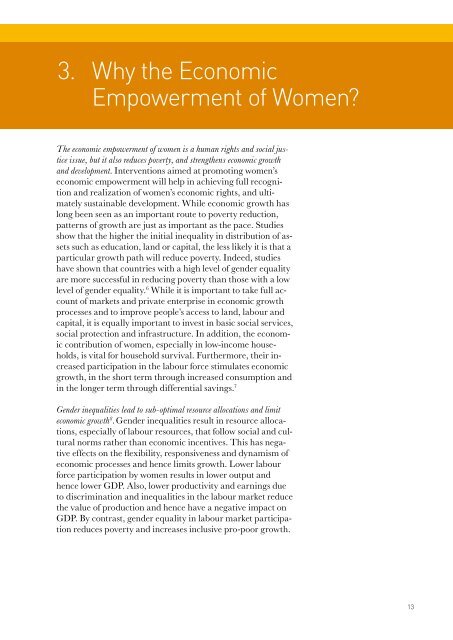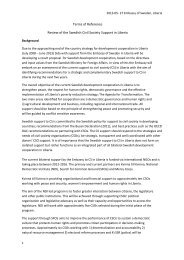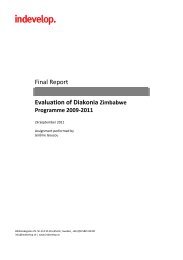Women's Economic Empowerment: Scope for Sida's Engagement
Women's Economic Empowerment: Scope for Sida's Engagement
Women's Economic Empowerment: Scope for Sida's Engagement
You also want an ePaper? Increase the reach of your titles
YUMPU automatically turns print PDFs into web optimized ePapers that Google loves.
3. Why the <strong>Economic</strong><strong>Empowerment</strong> of Women?The economic empowerment of women is a human rights and social justiceissue, but it also reduces poverty, and strengthens economic growthand development. Interventions aimed at promoting women’seconomic empowerment will help in achieving full recognitionand realization of women’s economic rights, and ultimatelysustainable development. While economic growth haslong been seen as an important route to poverty reduction,patterns of growth are just as important as the pace. Studiesshow that the higher the initial inequality in distribution of assetssuch as education, land or capital, the less likely it is that aparticular growth path will reduce poverty. Indeed, studieshave shown that countries with a high level of gender equalityare more successful in reducing poverty than those with a lowlevel of gender equality. 6 While it is important to take full accountof markets and private enterprise in economic growthprocesses and to improve people’s access to land, labour andcapital, it is equally important to invest in basic social services,social protection and infrastructure. In addition, the economiccontribution of women, especially in low-income households,is vital <strong>for</strong> household survival. Furthermore, their increasedparticipation in the labour <strong>for</strong>ce stimulates economicgrowth, in the short term through increased consumption andin the longer term through differential savings. 7Gender inequalities lead to sub-optimal resource allocations and limiteconomic growth 8 . Gender inequalities result in resource allocations,especially of labour resources, that follow social and culturalnorms rather than economic incentives. This has negativeeffects on the flexibility, responsiveness and dynamism ofeconomic processes and hence limits growth. Lower labour<strong>for</strong>ce participation by women results in lower output andhence lower GDP. Also, lower productivity and earnings dueto discrimination and inequalities in the labour market reducethe value of production and hence have a negative impact onGDP. By contrast, gender equality in labour market participationreduces poverty and increases inclusive pro-poor growth.13















